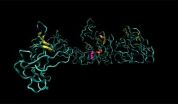(Press-News.org) CAMBRIDGE, MA -- Rett syndrome, a rare genetic disorder that causes mental retardation, autism, and physical deformities, has no cure. However, a small clinical trial has found that a growth factor known as IGF1 can help treat some symptoms of the disease.
Children who received the drug for four weeks showed improvements in mood and anxiety, as well as easier breathing, in a trial led by researchers at Boston Children's Hospital. MIT scientists first identified IGF1 as a possible treatment for Rett syndrome in 2009.
"This trial shows that IGF1 is safe in the cohort of 12 kids, and at least on certain measures, it provides some effectiveness," says Mriganka Sur, the Paul E. and Lilah Newton Professor of Neuroscience at MIT and an author of the paper, which appeared recently in the Proceedings of the National Academy of Sciences.
In two other PNAS papers appearing today, Sur's lab reports some of the molecular detail behind the mechanism of IGF1 action. His team also found that in mice, another drug, clenbuterol, appears to enhance the effectiveness of IGF1.
Unraveling disease mechanism
Rett syndrome affects about one in 10,000 girls. The gene that causes the disease, MeCP2, is carried on the X chromosome, so the condition is usually fatal in boys because they don't have a healthy X chromosome to counteract the effects of the mutated version.
Girls with Rett syndrome tend to have smaller brains, smaller neurons, and fewer synapses than usual. Common symptoms include handwringing, seizures, gastrointestinal disorders, and difficulty walking, speaking, and breathing. However, there is a great deal of variability among patients because in every body cell, only one copy of the X chromosome is active. If a majority of cells express the healthy version of the X chromosome, the symptoms are less severe.
The MeCP2 gene codes for a protein that modifies chromatin — the protein-DNA complex that forms within a cell's nucleus. These chromatin modifications influence the expression of genes by controlling access to DNA. MeCP2 also modifies microRNAs, which are very short strands of RNA that help regulate gene expression.
Four years ago, researchers in Sur's lab found that they could reverse many of the symptoms of Rett syndrome in mice by treating them with a small fragment of insulin-like growth factor 1 (IGF1). In one of the recent PNAS papers, the researchers found that the full-length form of IGF1 also reverses symptoms in mice, which is significant because the U.S. Food and Drug Administration has already approved the full-length form to treat children whose growth is stunted.
Three years ago, initial results of that study provided the anchor for the recent clinical trial to go forward, Sur says. The study was led by former MIT postdoc Jorge Castro and graduate student Rodrigo Garcia.
In the other PNAS paper, Sur, lead author Nikolaos Mellios, an MIT postdoc, and colleagues discovered a complex pathway by which MeCP2 regulates IGF1 production. They found that without MeCP2, there is not enough brain-derived neurotropic factor (BDNF), which in turn reduces the amount of a microRNA processing factor called lin28a. Loss of lin28a leads to overproduction of a microRNA called let7f, and this abundance of let7f inhibits IGF1production.
To help confirm that this pathway is correct, the researchers treated mice lacking MeCP2 with clenbuterol, a drug that is known to stimulate BDNF production. After this treatment, the lin28a protein was produced at normal levels, restoring the rest of the pathway that leads to IGF1 production. The treatment also improved breathing, motor coordination, and the ability to recall social interactions.
Unlike most other studies of Rett syndrome treatment, both of these studies included female mice, which Sur says is important because all human patients are girls.
In the United States, clenbuterol is approved as a veterinary treatment for asthma, but not for human use; it is approved for human use in Europe. Sur says his team has no plans for clinical trials of clenbuterol. "We just put our findings out there. More research is needed before it can be used in humans, but the possibility certainly exists," says Sur, who is director of the Simons Center for the Social Brain and a member of MIT's Picower Institute for Learning and Memory.
Modest improvements
In the Phase I clinical trial of IGF1, the researchers gave the drug to 12 girls ranging in age from 2 to 10, all of whom had Rett syndrome. Each girl received the drug for four weeks, and there were no adverse side effects. Patients also experienced some improvements in mood and in respiratory function, which is particularly important because apnea and irregular breathing are common features of Rett syndrome, Sur says. Respiratory function also provides a way to measure the effects of the drug without having to rely on patient or family reports of neurological symptoms.
"An autonomic measure such as respiration is immune to a placebo effect and provides a strong biomarker for treatment of the disorder," Sur says.
The trial was led by Walter Kaufmann, director of the Rett Syndrome Program at Boston Children's Hospital, and performed by researchers there and at Harvard Medical School. A larger Phase II trial, with 30 children, is now underway.
If IGF1 proves successful in treating Rett syndrome, it might also find use against other disorders that involve some of the same molecular pathways, such as other forms of autism, Sur says.
"It's a window into how you might treat a developmental disorder based on the molecular mechanisms. With any autism that affects these molecules, this drug may well end up being effective," he says.
Sur's lab is now working on making neurons from human skin cells taken from Rett syndrome patients so the researchers can study more closely what goes wrong in them. He also hopes to uncover the specific effects caused by mutations in different sections of the MeCP2 gene, which could lead to drugs that target individual effects more specifically, Sur says.
"There is no doubt that you should treat neuropsychiatric disorders in an intensely personal way," he says. "I hope in my lifetime we will reach a place where some girls with Rett syndrome get IGF1 alone because they have a deficit in the part of MeCP2 that strongly regulates IGF1 through the microRNA mechanism, while some girls get much less IGF1 but receive something else that affects other parts of what MeCP2 does."
INFORMATION:
The research was funded by the National Eye Institute, the National Institutes of Health, the Simons Foundation, and the National Science Foundation.
Written by Anne Trafton, MIT News Office
Rett syndrome drug shows promise in clinical trial
2014-06-23
ELSE PRESS RELEASES FROM THIS DATE:
New analysis reveals previously 'hidden diversity' of mouth bacteria
2014-06-23
MBL, WOODS HOLE, MA—A new computational method for analyzing bacterial communities has uncovered closely related, previously indistinguishable bacteria living in different parts of the human mouth. The technique, developed by Marine Biological Laboratory (MBL) scientists, provides high taxonomic resolution of bacterial communities and has the capacity to improve the understanding of microbial communities in health and disease. The study will be published in PNAS Online Early Edition the week of June 23-27, 2014.
An important step in understanding the role of oral bacteria ...
Computational technique provides new insight into oral microbiome
2014-06-23
CAMBRIDGE, Mass., June 23, 2014—Scientists have applied a new technique to comprehensively analyze the human oral microbiome—providing greater knowledge of the diversity of the bacteria in the mouth. For the first-time, scientists can provide high-resolution bacterial classification at the sub-species level. This work will enable researchers to more closely examine the role of bacterial communities in health and disease.
The study, "Oligotyping analysis of the human oral microbiome," will be published in the Proceedings of the National Academy of Sciences and available ...
Delivering drugs on cue
2014-06-23
June 23, Boston -- Current drug-delivery systems used to administer chemotherapy to cancer patients typically release a constant dose of the drug over time - but a new study challenges this "slow and steady" approach and offers a novel way to locally deliver the drugs "on demand," as reported in the Proceedings of the National Academy of Sciences (PNAS).
Led by David J. Mooney, Ph.D., a Core Faculty member at Harvard's Wyss Institute for Biologically Inspired Engineering and the Robert P. Pinkas Family Professor of Bioengineering at the Harvard School of Engineering ...
Bone loss persists 2 years after weight loss surgery
2014-06-23
CHICAGO, IL — A new study shows that for at least two years after bariatric surgery, patients continue to lose bone, even after their weight stabilizes. The results—in patients undergoing gastric bypass, the most common type of weight loss surgery—were presented Monday at the joint meeting of the International Society of Endocrinology and the Endocrine Society: ICE/ENDO 2014 in Chicago.
"The long-term consequences of this substantial bone loss are unclear, but it might put them at increased risk of fracture, or breaking a bone," said Elaine Yu, MD, MSc, the study's principal ...
A disease of mistaken identity
2014-06-23
The symptoms of Cushing disease are unmistakable to those who suffer from it – excessive weight gain, acne, distinct colored stretch marks on the abdomen, thighs and armpits, and a lump, or fat deposit, on the back of the neck. Yet the disorder often goes misdiagnosed.
To help combat misdiagnosis, Saleh Aldasouqi, an associate professor in the College of Human Medicine at Michigan State University, is drawing more attention to the rare disease through a case study, which followed a young patient displaying classic, yet more pronounced signs of the condition.
Caused ...
Date labeling confusion contributes to food waste
2014-06-23
Date labeling variations on food products contribute to confusion and misunderstanding in the marketplace regarding how the dates on labels relate to food quality and safety, according to a scientific review paper in the July issue of Comprehensive Reviews in Food Science and Food Safety. This confusion and misunderstanding along with different regulatory date labeling frameworks, may detract from limited regulatory resources, cause financial loss, and contribute to significant food waste.
In the United States, the United States Department of Agriculture Economic Research ...
Understanding the ocean's role in Greenland glacier melt
2014-06-23
The Greenland Ice Sheet is a 1.7 million-square-kilometer, 2-mile thick layer of ice that covers Greenland. Its fate is inextricably linked to our global climate system.
In the last 40 years, ice loss from the Greenland Ice Sheet increased four-fold contributing to one-quarter of global sea level rise. Some of the increased melting at the surface of the ice sheet is due to a warmer atmosphere, but the ocean's role in driving ice loss largely remains a mystery.
Research by scientists at Woods Hole Oceanographic Institution (WHOI) and the Univ. of Oregon sheds new light ...
Protecting and connecting the Flathead National Forest
2014-06-23
A new report from the Wildlife Conservation Society (WCS) calls for completing the legacy of Wilderness lands on the Flathead National Forest in Montana. The report identifies important, secure habitats and landscape connections for five species—bull trout, westslope cutthroat trout, grizzly bears, wolverines, and mountain goats. These iconic species are vulnerable to loss of secure habitat from industrial land uses and/or climate change.
Located in northwest Montana adjacent to Glacier National Park, the 2.4 million-acre Flathead Forest is a strategic part of the stunning ...
Ferroelectric switching seen in biological tissues
2014-06-23
Measurements taken at the molecular scale have for the first time confirmed a key property that could improve our knowledge of how the heart and lungs function.
University of Washington researchers have shown that a favorable electrical property is present in a type of protein found in organs that repeatedly stretch and retract, such as the lungs, heart and arteries. These findings are the first that clearly track this phenomenon, called ferroelectricity, occurring at the molecular level in biological tissues.
The researchers published their findings online June 23 ...
Grinding away at history using 'forensic' paleontology and archeology
2014-06-23
Tulsa, Ok. – The Society for Sedimentary Geology (SEPM) announces an unusual paper in their journal PALAIOS that combines 'forensic' paleontology and archeology to identify origins of the millstones commonly used in the 1800's. While all millstones were used similarly, millstones quarried in France were more highly valued than similar stones quarried in Ohio, USA.
Over four years the scientific team located millstones by visiting historical localities in Ohio, then studied them and identified unique characteristics between the coveted French buhr and the locally sourced ...






